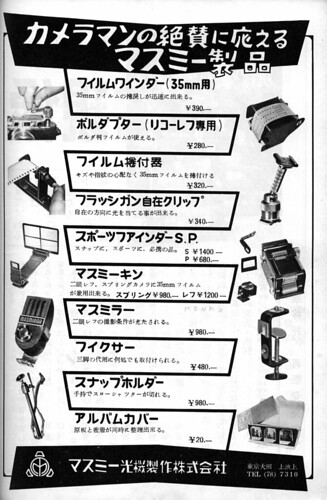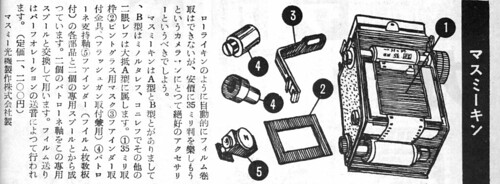Masmy Kin
The Masmy Kin (マスミーキン) is a conversion kit allowing to use 35mm film in 120 film cameras, made in the mid-1950s by the Japanese company Masmy Kōki Seisaku.
 
|
| Advertisements by Masmy showing the Masmy Kin in special issues of Photo Art. Left: June 1955. Right: October 1955. (Image rights) |
Three main models exist: for folding cameras, for regular TLR cameras (i.e. Rolleicord copies), and for the Ricohflex III and similar cameras. These three models are listed in an advertisement in the June 1955 special issue of Photo Art,[1] whereas the advertisement in the October special issue does not mention that for the Ricohflex.[2] The models for TLR cameras cost ¥1,200, and that for folding cameras costs ¥980.

|
| Column on the Masmy Kin in the June 1955 special issue of Photo Art. (Image rights) |
The Masmy Kin for TLR cameras was itself made in two versions: the model A (A型) fitting most TLR cameras patterned after the Rolleiflex and Rolleicord, and the model B (B型) for the Minoltaflex and Koniflex.[3] The film advance is manually controlled by counting the clicks emitted by a device contained inside the exposure frame. This extremely primitive method is usable only on cameras which allow double exposures; others will require to advance the film by a full frame width (6cm or 4.5cm). It helped to keep the price low: in 1955, the Masmy Kin, at ¥1,200, was ten times cheaper than the f/3.5 Rolleikin, at ¥11,900.[4] It
The whole set consists of the following elements:
- a tunnel-like exposure frame (no.1 on the above drawing);
- adapters to hold the film cassettes at both ends (no.4);
- two film spools, replacing the spools contained inside regular film cassettes;
- a mask for the viewing screen (no.2);
- an auxiliary viewfinder (no.5), useful for vertical pictures, with a manual exposure counter disc, reminding the number of frames already taken;
- an L-shaped bracket with an accessory shoe (no.3), to attach the viewfinder on cameras lacking that element.

|
| Column on the Masmy Kin for Mamiya Six in Shashin Kōgyō October 1955. (Image rights) |
A specific version for the Mamiya Six, fitting the models IV, IVB, V and K, was announced in the October 1955 issue of Shashin Kōgyō.[5] The moving film plane and removable exposure plate of the Mamiya Six certainly made it necessary to adapt the original design, but the details of the adaptation are unknown. The price of ¥980 is the same as the regular version for folding cameras.

|
| Column on the Masmy Kin for Ricohflex in Shashin Kōgyō January 1956. (Image rights) |
The version for the Ricohflex announced in the January 1956 issue of Shashin Kōgyō,[6] priced at ¥490, is certainly different from that advertised in June 1955. The kit contains a set of masks for 24×36mm, 24×24mm or 18×24mm exposures, these three formats respectively corresponding to eight, five and four perforations. It seems that the kit altogether replaces the internal exposure chamber of the Ricohflex, and contains a disc with a manually controlled exposure counter, perhaps attached instead of the camera's original advance knob.
Notes
- ↑ Advertisement in the June 1955 special issue of Photo Art, p.125.
- ↑ Advertisement in the October 1955 special issue of Photo Art, p.158.
- ↑ Column in the June 1955 special issue of Photo Art, p.54.
- ↑ Prices in the June 1955 special issue of Photo Art, p.54.
- ↑ Shashin Kōgyō October 1955, p.256.
- ↑ Shashin Kōgyō January 1956, p.28.
Bibliography
- Photo Art rinji zōkan: Kamera akusesarī zensho (フォトアート臨時増刊・カメラアクセサリー全書, Photo Art special issue: All the camera accessories). June 1955, no.80 of the magazine.
- "Zukai: Akusesarī no mekanikku. 14: Nigan-refu kamera sen'yō no akusesarī." (図解・アクセサリーのメカニック・14・二眼レフカメラ専用のアクセサリー. Drawings: accessory mechanisms. 14: Accessories specific to TLR cameras.) P.54.
- Advertisement by Masmy Kōki Seisaku on p.125.
- Photo Art rinji zōkan: Kamera no chishiki (フォトアート臨時増刊・カメラの知識, Photo Art special issue: Knowledge of cameras). October 1955, no.87 of the magazine. Advertisement by Masmy Kōki Seisaku on p.158.
- Shashin Kōgyō no.40, October 1955. "Nyūsu furashu" (ニュースフラシュ, News flash). P.256.
- Shashin Kōgyō no.43, January 1956. "News Flash". P.28.